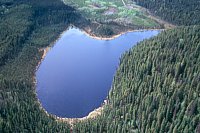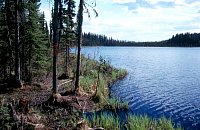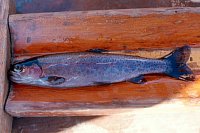 |
|||||
|
2000 ANGLING SAMPLE A total of 65 rainbow trout were captured by angling, for an angler CPUE of 1.91 RB per angler-hour. No other species were captured. See Appendix 3 for specific fish attribute data. CONDITION In 1999, trout were only weighed to the nearest 50 g (see Table 2 for mean condition data), therefore a full condition assessment cannot be derived from this data set. In 2000, fish were weighed to the nearest 1 g, facilitating a more accurate assessment of condition. The trout sampled exhibited a mean condition factor of 1.01, which is within the normal range expected for a healthy population. No abnormalities were observed in the relative weight of the fish sampled. LENGTH FREQUENCY DISTRIBUTION and GROWTH
The population sampled in 1999 consisted exclusively of 3- and 4-year-old fish (see Appendix 1); no 2-year-olds (previously stocked on October 4, 1998) were obtained. This may be attributable to the small sample size, the location of the net set, or to ageing error of the smaller fish that were sampled. The mean fork length of 4-year-old fish sampled in 1999 was 300 mm, while the nine 4-year-old fish sampled in 1997 had a mean length of 335 mm (data on file). Competitive pressure between annual cohorts may account for the smaller size of the 4-year-olds sampled in 1999, as 1,500 fish were released in the spring of 1996 followed by 3,100 fish in the fall of 1997. By contrast, the cohort sampled in 1997 consisted of only 1,500 fish at the time of stocking, and no fish were released in the year prior to or after this release. While age data is not available for the 2000 angling sample, it is evident from Figure 2 that growth was further curtailed as a result of the 3 consecutive fall releases of summer-reared trout. The 2- and 3-year-olds do not occupy discrete size classes and are likely experiencing intra- and intercohort competition. Despite the larger sample size obtained in 2000, no fish larger than 345 mm were captured (PHOTO 3) further supporting that growth rates are being negatively influenced by high stocking rates. Management Recommendations Nelson Lake was stocked to create a low-use, high yield "put and take" recreational rainbow trout fishery (note to file, 1989). While its management objectives have not changed over the last decade, the rate of stocking and the size of yearlings released into the lake have varied year to year, confounding our ability to understand the effects of stock density on catch success and growth. Nonetheless, the 1999 and 2000 surveys show that the 1997-1999 annual fall stocking program has benefitted catch success rates at the cost of reduced growth. This downward pressure on growth has affected the quality of the recreational fishery, with less than 36% of the 2000 angler catch exceeding 250mm in fork length.
To establish a fishery that provides a reasonable yield yet affords the angler with fish that are worth retaining, the frequency of stocking should be reduced to alternate-year releases of 2,500 fish. Nelson Lake was not stocked in 2000, and is not scheduled to be stocked in 2001; this should allow the existing cohorts to grow and be available to anglers from 2001 through 2003. Stocking will recommence in 2002. If the lake is to receive continued attention by the Spruce City Wildlife Association, a consistent approach to stocking and monitoring the lake's fishery should be maintained. This approach would allow fisheries managers to evaluate whether the revised stocking schedule, or the continuation of a revised summer rearing program, addresses the management objectives for Nelson Lake. A follow-up survey in the summer of 2004 would provide a comparative data set from which to evaluate the response of the fishery to either of these options. Literature Cited. Westcott, 1988. A Reconaissance Survey of Nelson
Lake. Ministry of Environment. Prince George. For More Information: Contact :Ted Zimmerman
|
|||||||||||||||||||||||||||||||||||||||||||||||||||||||||||||||||||||||




